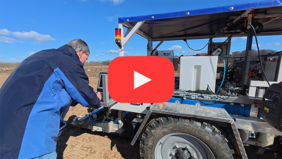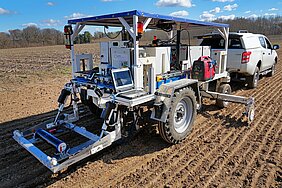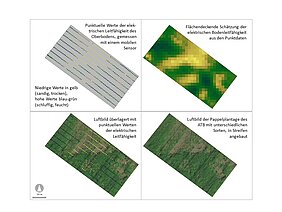Precise information about agricultural soils is key to managing them more efficiently and sustainably. Researchers at the Leibniz institutes FBH and ATB have recently enhanced an existing sensor platform for mobile soil mapping of agricultural fields. By integrating an innovative Raman system, soil components can now be identified on a substance-specific level while the vehicle is on the move – in real time, on site, and with high spatial resolution. This method holds the potential to significantly reduce time and cost associated with conventional soil sampling. At the same time, it enables more targeted fertilization, contributing to more environmentally friendly farming practices.
To manage their fields effectively, farmers need precise information about nutrients, pH levels, and other key soil parameters. Soil composition varies not only across different areas but also at different depths. For optimal cultivation, agriculturists depend on detailed maps that show exactly which properties are present in which parts of the field. Currently, this information is obtained by taking soil samples and analyzing them in the lab — a time-consuming process. Only after receiving the results can farmers apply the nutrients that are actually needed.
High-tech tools for rapid soil analysis and targeted fertilisation
The recently tested mobile sensor platform opens up new possibilities. RapidMapper – a high-tech platform for soil mapping developed at the Leibniz Institute for Agricultural Engineering and Bioeconomy (ATB) – has been enhanced with a technological solution from the Ferdinand-Braun-Institut (FBH). As part of the BMBF-funded project Intelligence for Soil (I4S), led by ATB, researchers at FBH developed a portable Raman measurement system for on-site soil analysis. This system enables fast and spatially resolved detection of the molecular composition of soil. It uses Shifted Excitation Raman Difference Spectroscopy (SERDS), which is based on a dual-wavelength Y-diode laser specially developed at FBH. This approach allows Raman signals to be efficiently separated from disturbing influences such as ambient light or fluorescence.
The novel SERDS system was integrated into ATB’s RapidMapper and successfully used in initial field tests. Dr. Martin Maiwald, head of the Laser Sensors Lab at FBH, who developed the system together with the institute’s in-house Prototype Engineering Lab, explains: “Using the Raman sensor head, which was integrated into the existing probe and lowered into the topsoil during traversal, it was possible for the first time to detect soil components at a depth of five to ten centimeters with SERDS – while in motion.” FBH also developed dedicated software to control the system and continuously record measurement data – Raman spectra along with the corresponding GPS coordinates.
Traditional soil sampling involves collecting samples from multiple locations and sending them to a laboratory for analysis. In the future, the sensor system could perform this process directly in the field – more quickly, efficiently, and cost-effectively than conventional sample testing. The SERDS module adds important parameters to the RapidMapper’s capabilities, says Dr. Robin Gebbers, agricultural scientist at ATB: “Until now, our research platform could capture pH values, humus content, and soil texture. With the newly integrated SERDS spectroscopy, we aim to gain additional insights — for example, into carbonates and various organic substances in the soil.” Dr. Gebbers is optimistic: “The first test run was a big step forward. At our soil testing track in the Fieldlab for Digital Agriculture, we were able to demonstrate that SERDS measurements in soils are possible from a mobile platform while in motion.” The data collected during this test is currently being evaluated.
Next steps toward comprehensive soil mapping
The I4S project partners are already working on their next objective: an integrated system designed to enable optimal and environmentally sustainable management of soil fertility directly in the field. This would make it possible to map agricultural land more comprehensively than before. Developments are aimed at a wide range of users – including agricultural service providers, farmers, machinery manufacturers, and others who rely on detailed soil data.
Contact
Jessica Lietze
Officer for Public Ralations, ATB
Telefon: +49 331 5699-819
E-Mail: presse@atb-potsdam.de
Petra Immerz
Communications Manager, Ferdinand-Braun-Institut gGmbH, Leibniz-Institut für Höchstfrequenztechnik
Tel.: +49 030.6392-2626
E-Mail: petra.immerz@fbh-berlin.de
Dr. Robin Gebbers
Agricultural Scientist, ATB
Telefon: +49 331 5699-413
E-Mail: rgebbers@atb-potsdam.de
About the FBH
The Ferdinand-Braun-Institut, Leibniz-Institut für Höchstfrequenztechnik (FBH) is an application-oriented research institute in the fields of high-frequency electronics, photonics and quantum physics. It researches electronic and optical components, modules, and systems based on compound semiconductors. These devices are key enablers that address the needs of today’s society in fields like communications, energy, health, and mobility. Specifically, FBH develops light sources from the infrared to the ultra-violet spectral range: high-power diode lasers with excellent beam quality, UV light sources and hybrid laser systems. Applications range from medical technology, high-precision metrology, and sensors to optical communications in space and integrated quantum technology. In the field of microwaves, FBH develops high-efficiency multi-functional power amplifiers, and millimeter wave frontends targeting energy-efficient mobile communications as well as car safety systems. The FBH has a strong international reputation and ensures rapid transfer of technology by working closely with partners in industry and research. The institute has a staff of 390 employees and a revenue of 43.3 million euros. It is a member of the Leibniz Association and part of »Research Fab Microelectronics Germany«.
About ATB
The Leibniz Institute for Agricultural Engineering and Bioeconomy is a pioneer and a driver of systemic-technological bioeconomy research.
We create the scientific foundation for the transformation of agricultural, food, other industrial and energy systems into a sustainable bio-based circular economy. We develop, deploy and integrate technologies, techniques, processes and management strategies, strategically integrate a variety of bioeconomic production systems within a comprehensive system approach and manage them in a knowledge-driven, adaptive and extensively automated way using converging technologies.
We conduct research in dialogue with society, policymakers, industry and other stakeholders - knowledge-driven and application-inspired.



